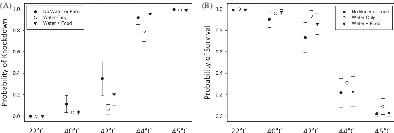当前位置:
X-MOL 学术
›
Ecol. Entomol.
›
论文详情
Our official English website, www.x-mol.net, welcomes your feedback! (Note: you will need to create a separate account there.)
The upper thermal tolerance for a Texas population of the hairy maggot blow fly Chrysomya rufifacies Macquart (Diptera: Calliphoridae)
Ecological Entomology ( IF 2.2 ) Pub Date : 2020-06-23 , DOI: 10.1111/een.12902 Travis W. Rusch 1 , Ashleigh M. Faris 1, 2 , Lauren E. J. Beebe 1 , Jeffery K. Tomberlin 1 , Aaron M. Tarone 1
Ecological Entomology ( IF 2.2 ) Pub Date : 2020-06-23 , DOI: 10.1111/een.12902 Travis W. Rusch 1 , Ashleigh M. Faris 1, 2 , Lauren E. J. Beebe 1 , Jeffery K. Tomberlin 1 , Aaron M. Tarone 1
Affiliation

|
The hairy maggot blow fly (Chrysomya rufifacies: Macquart) is an invasive necrophagous fly found throughout the continental United States. Chrysomya rufifacies is of medical/veterinary, forensic, and ecological importance due to its ability to cause myiasis, colonise human remains, and displace native Diptera. However, little is known about their upper thermal tolerance, which could be used to better predict their invasion potential. We investigated the upper thermal tolerance of C. rufifacies exposed to different temperatures (20–45 °C), times (1–6 h), and nutrients (no food or water, water only, or a food‐water mixture) for both sexes and two age ranges (young = 6–8 days post pupal emergence; old = 9–11 days post pupal emergence). As temperature or duration increased, the probability of knockdown increased (0–100% at 20 and 45 °C and from 41 to 75% at 1 and 6 h), while the probability of survival decreased (99–2% at 20 and 45 °C and from 75 to 28% at 1 and 6 h). The availability of nutrients increased thermal tolerance at moderate temperatures (40 and 42 °C). Female flies were more thermally tolerant than males (probability of knockdown = 49% vs 58%; probability of survival = 58% vs 46%). Thermal tolerance did not differ by age. These data reveal details about the upper thermal tolerance for a single population of C. rufifacies, and suggest that environmental and organismal factors ought to be considered in order to make meaningful predictions about the invasion potential of C. rufifacies in North America.
中文翻译:

德克萨斯州毛蛆苍蝇 Chrysomya rufifacies Macquart(双翅目:Calliphoridae)的耐热上限
毛蛆苍蝇(Chrysomya rufifacies:Macquart)是一种在美国大陆各地发现的侵入性食尸蝇。Chrysomya rufifacies 在医学/兽医、法医和生态学方面具有重要意义,因为它能够引起蝇蛆病、定植人类遗骸并取代原生双翅目。然而,人们对其较高的热耐受性知之甚少,这可用于更好地预测它们的入侵潜力。我们研究了 C. rufifacies 暴露于不同温度 (20–45 °C)、时间 (1–6 h) 和营养物质(无食物或水、仅水或食物-水混合物)的上限热耐受性性别和两个年龄范围(幼虫 = 蛹出现后 6-8 天;老 = 蛹出现后 9-11 天)。随着温度或持续时间的增加,击倒概率增加(在 20 和 45 °C 时为 0-100%,在 1 和 6 小时时从 41% 增加到 75%),而存活概率降低(在 20 和 45 °C 时为 99-2%,从 75 到28% 在 1 和 6 小时)。在中等温度(40 和 42 °C)下,营养物质的可用性增加了热耐受性。雌性果蝇比雄性果蝇更耐热(击倒概率 = 49% 对 58%;存活概率 = 58% 对 46%)。耐热性不因年龄而异。这些数据揭示了关于单一种群 C. rufifacies 的上限热耐受性的详细信息,并表明应该考虑环境和生物因素,以便对北美 C. rufifacies 的入侵潜力做出有意义的预测。而存活概率降低(20 和 45 °C 时为 99-2%,1 小时和 6 小时时从 75% 降至 28%)。在中等温度(40 和 42 °C)下,营养物质的可用性增加了热耐受性。雌性果蝇比雄性果蝇更耐热(击倒概率 = 49% 对 58%;存活概率 = 58% 对 46%)。耐热性不因年龄而异。这些数据揭示了关于单个红褐色 C. 种群的耐热性上限的详细信息,并表明应该考虑环境和生物因素,以便对北美 C. rufifacies 的入侵潜力做出有意义的预测。而存活概率降低(20 和 45 °C 时为 99-2%,1 小时和 6 小时时从 75% 降至 28%)。在中等温度(40 和 42 °C)下,营养物质的可用性增加了热耐受性。雌性果蝇比雄性果蝇更耐热(击倒概率 = 49% 对 58%;存活概率 = 58% 对 46%)。耐热性不因年龄而异。这些数据揭示了关于单一种群 C. rufifacies 的上限热耐受性的详细信息,并表明应该考虑环境和生物因素,以便对北美 C. rufifacies 的入侵潜力做出有意义的预测。生存概率 = 58% 对 46%)。耐热性不因年龄而异。这些数据揭示了关于单个红褐色 C. 种群的耐热性上限的详细信息,并表明应该考虑环境和生物因素,以便对北美 C. rufifacies 的入侵潜力做出有意义的预测。生存概率 = 58% 对 46%)。耐热性不因年龄而异。这些数据揭示了关于单一种群 C. rufifacies 的上限热耐受性的详细信息,并表明应该考虑环境和生物因素,以便对北美 C. rufifacies 的入侵潜力做出有意义的预测。
更新日期:2020-06-23
中文翻译:

德克萨斯州毛蛆苍蝇 Chrysomya rufifacies Macquart(双翅目:Calliphoridae)的耐热上限
毛蛆苍蝇(Chrysomya rufifacies:Macquart)是一种在美国大陆各地发现的侵入性食尸蝇。Chrysomya rufifacies 在医学/兽医、法医和生态学方面具有重要意义,因为它能够引起蝇蛆病、定植人类遗骸并取代原生双翅目。然而,人们对其较高的热耐受性知之甚少,这可用于更好地预测它们的入侵潜力。我们研究了 C. rufifacies 暴露于不同温度 (20–45 °C)、时间 (1–6 h) 和营养物质(无食物或水、仅水或食物-水混合物)的上限热耐受性性别和两个年龄范围(幼虫 = 蛹出现后 6-8 天;老 = 蛹出现后 9-11 天)。随着温度或持续时间的增加,击倒概率增加(在 20 和 45 °C 时为 0-100%,在 1 和 6 小时时从 41% 增加到 75%),而存活概率降低(在 20 和 45 °C 时为 99-2%,从 75 到28% 在 1 和 6 小时)。在中等温度(40 和 42 °C)下,营养物质的可用性增加了热耐受性。雌性果蝇比雄性果蝇更耐热(击倒概率 = 49% 对 58%;存活概率 = 58% 对 46%)。耐热性不因年龄而异。这些数据揭示了关于单一种群 C. rufifacies 的上限热耐受性的详细信息,并表明应该考虑环境和生物因素,以便对北美 C. rufifacies 的入侵潜力做出有意义的预测。而存活概率降低(20 和 45 °C 时为 99-2%,1 小时和 6 小时时从 75% 降至 28%)。在中等温度(40 和 42 °C)下,营养物质的可用性增加了热耐受性。雌性果蝇比雄性果蝇更耐热(击倒概率 = 49% 对 58%;存活概率 = 58% 对 46%)。耐热性不因年龄而异。这些数据揭示了关于单个红褐色 C. 种群的耐热性上限的详细信息,并表明应该考虑环境和生物因素,以便对北美 C. rufifacies 的入侵潜力做出有意义的预测。而存活概率降低(20 和 45 °C 时为 99-2%,1 小时和 6 小时时从 75% 降至 28%)。在中等温度(40 和 42 °C)下,营养物质的可用性增加了热耐受性。雌性果蝇比雄性果蝇更耐热(击倒概率 = 49% 对 58%;存活概率 = 58% 对 46%)。耐热性不因年龄而异。这些数据揭示了关于单一种群 C. rufifacies 的上限热耐受性的详细信息,并表明应该考虑环境和生物因素,以便对北美 C. rufifacies 的入侵潜力做出有意义的预测。生存概率 = 58% 对 46%)。耐热性不因年龄而异。这些数据揭示了关于单个红褐色 C. 种群的耐热性上限的详细信息,并表明应该考虑环境和生物因素,以便对北美 C. rufifacies 的入侵潜力做出有意义的预测。生存概率 = 58% 对 46%)。耐热性不因年龄而异。这些数据揭示了关于单一种群 C. rufifacies 的上限热耐受性的详细信息,并表明应该考虑环境和生物因素,以便对北美 C. rufifacies 的入侵潜力做出有意义的预测。



























 京公网安备 11010802027423号
京公网安备 11010802027423号